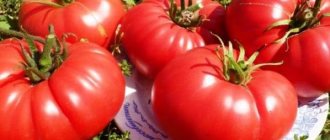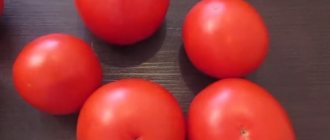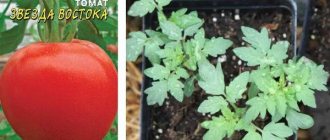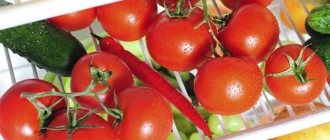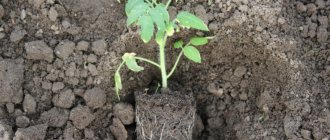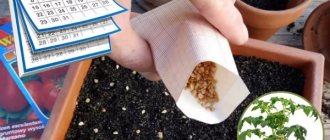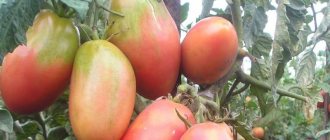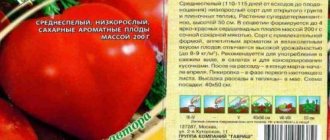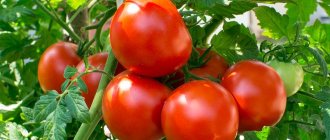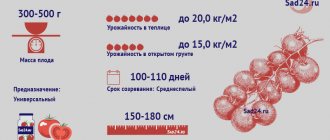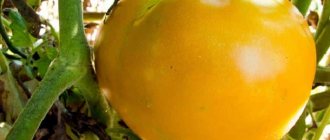For those looking for an interesting, easy-to-grow tomato, the Pepper variety is suitable. Neat fruits are an excellent solution for fresh salads and whole canning.
| Height | Landing location | Ripening time | Fruit color | Fruit size | Origin | Fruit shape |
| Medium height | Greenhouse, Open ground | Early ripening | Reds | Average | Variety | Pepper-shaped |
A joy for any gardener is the hardy tomato Velvet Season: a complete description of the variety
Velvet season is a proven tomato with which it is possible to get good yields even in risky farming conditions. The variety is suitable for northern and southern regions; it bears fruit consistently in unfavorable weather. Initially bred by breeders for the harsh climate of Siberia.
| Height | Landing location | Ripening time | Fruit color | Fruit size | Origin | Fruit shape |
| short | Greenhouse, Open ground | Mid-early | Reds | Large | Variety | Flat-round |
Description and characteristics of the variety
Velvet Season is a determinate, low-growing variety. Compact shoots grow up to 50-60 cm in height. Stems are erect and strong.
Dark cherry tomatoes have a pleasant sweetish taste and a sourish tint. At the break, the flesh is sugary and fleshy, dense. Tomatoes are used universally - for salads, pickling, canning, and ketchup. Thanks to the elastic skin, the fruits are resistant to cracking.
Advantages and disadvantages
- resistance to cold temperatures;
- tolerance to drought and heat;
- excellent germination;
- marketable condition;
- excellent taste;
- friendly fruiting;
- good immunity against fungi.
Minuses:
Features of cultivation and storage
Seedlings begin to grow from the beginning of March until May. Seeds are sown in light fertile soil, enriched with ash and compost, with the addition of peat and sand. To speed up germination, use “Agat 25” or “Kornevin”.
Seedling care includes:
- until germination, keeping at 22-24 °C;
- hardening at 14-15 °C;
- irrigation with warm water;
- diving with 3 true leaves.
Reviews about tomatoes
Irina, Voronezh: “I love these tomatoes for their pleasant taste. They are quite small, so they are suitable for whole canning in small jars. In addition, “peppers” are prepared dried. It turns out very tasty."
If a gardener wants to get a decent harvest of tomatoes, then he should pay attention to the mid-season tomato variety - Pepper. The tomato we are considering is suitable for growing both under film and in open ground. As a result of the efforts of the owners, over time, bushes up to one and a half to two meters in height with red, fleshy, elongated, pepper-shaped fruits will certainly appear in the beds. Each tomato with the gentle nickname Pepper reaches a mass of 50 to 100 grams.
Features of cultivation
To get a bountiful harvest of Dobry f1 tomatoes, it is better to grow the seedlings yourself, taking into account the following rules.
Carry out pre-sowing seed treatment:
- For disinfection, use a solution of potassium permarganate, hold for 20 minutes, then rinse.
- To improve germination, soak in growth stimulants such as Epin, Zircon for 6 hours.
The soil for tomato seedlings is prepared light and loose, from a mixture of garden soil, compost and ash. If the soil in the garden is clayey and heavy, add peat. Alternatively, you can use coconut substrate.
Garden soil for seedlings must undergo pre-treatment; for disinfection, it must be calcined in the oven or frozen.
Growing seedlings
Treated seeds are sown in moist soil at a distance of 2-3 cm, sprinkled with earth on top and lightly compacted. The seedling container is covered with newspaper or plastic film (not airtight) and placed in a place with a comfortable temperature (24-25 degrees).
The emergence of seedlings must be observed - as soon as the first loops begin to appear, they are taken to the most illuminated place.
The next stage of caring for seedlings - for two weeks - is very important, since it is necessary to maintain maximum illumination for 11-12 hours a day and temperature conditions: night - about 14 degrees, daytime - about 16 degrees.
After hardening, the temperature is increased by 5 -7 degrees
Plants are watered carefully; the soil should be only slightly moist. With the appearance of several true leaves, the tomatoes are dived into separate cups or large boxes, keeping a distance between them of at least 20 cm
During the remaining time before planting, the seedlings should be well lit, and care should consist of moderate watering and fertilizing (1-2 times during the entire period). Plants are considered ready for planting in the greenhouse after 45-55 days. The seedlings should not be allowed to overgrow or stretch.
Planting in a greenhouse usually begins with the onset of stable warmth, when the threat of night frosts has passed. The distance between plants in a row when forming 1-2 stems is 50 cm.
Holes are prepared for seedlings, compost, ash, and complex mineral fertilizers are added and watered. After planting, the plants are watered again, the roots are covered with soil, and supports are installed, since in the future the plant will stretch out and will need to be tied up.
When planting seedlings, you can only use completely rotted compost or manure.
If there is a threat of night frosts, it is advisable to provide additional arches and covering material, such as spunbond, in order to preserve the planted seedlings.
Caring for plants in a greenhouse
Growing tomatoes in a greenhouse has a number of features. Tomatoes prefer high soil moisture and low air humidity in the greenhouse. To achieve this effect, greenhouses are increasingly using mulching of the ground with grass, sawdust or other materials that protect the soil from evaporation and prevent weeds from breaking through.
To make plants feel comfortable in a greenhouse, you need to:
- Regular ventilation of the greenhouse through vents and doors (without creating drafts).
- Water the plants once a week. It is allowed to water only at the root, without moistening the leaves, in order to avoid sunburn.
- Regularly weed and loosen the soil.
- Mulching with grass clippings or weeds.
- Formation of plants into one or two stems.
- Pinching and trimming the lower yellowed leaves. This procedure is carried out in the morning so that the wounds have time to dry out during the day.
- Feed the tomatoes in the first two to three weeks with green fertilizer - a solution of infusion of mullein and fermented grass (the solution is prepared in a ratio of 1: 10).
- After the fruits appear, fertilizing with nitrogen-containing fertilizers is reduced and mineral fertilizers are added.
All types of fertilizing are carried out only after watering the plants in the greenhouse.
Plants in a greenhouse remove a much larger amount of nutrients from the soil than in open ground, so you need to very carefully monitor their development, adding the missing microelements to the fertilizing if necessary.
And then your favorite plants will thank you with a wonderful harvest.
Tomato Delicious - description and characteristics of the variety
Characteristics of the Delicious variety
Several different varieties are usually planted at the same time. Various salad varieties with soft skin and ass that can be preserved, having a medium size. Tomatoes of large varieties usually reach a weight of up to 500 grams. This tomato is absolutely enough for a salad for the whole family. No matter what you say, many people believe that large fruits cause a lot of trouble when growing.
Delicious is often confused with Delicious, but the variety, bred in America in 1964, has nothing in common with it. The indeterminate plant reaches up to 2 meters in height and has a small number of leaves on the stem. The growing season of the Delicious tomato is approximately 100-120 days. At the same time, the period for ripening is considered average, as well as the yield.
The fruit is flat and round in build with a glossy shiny surface of a reddish-orange color. The inside is fleshy and uniform, with small chambers for seeds. The fruit is resistant to cracking. Uniform dichogamy contributes to a sour flavor. The weight of one ripe vegetable is 0.5-0.6 kg.
Delicious tomatoes are planted in a greenhouse or on plots of land. However, in the middle zone, pomona gifts do not have time to ripen, so cultivation occurs under the cover of film. A known species rarely gets sick, but even if one shoot gets sick, the rest will remain untouched by the disease.
Nurturing
It is advisable to buy material for sowing, but some garden owners successfully prepare super-elite from their lands. At the same time, you should choose ripe ones to get beautiful tomato fruits from the bush.
For good seedlings, movra begins to be planted in mid-March. Seedlings love warmth, thanks to this (if the room temperature is low, the place is equipped with a heat lamp.
After the appearance of the first leaves of the seedlings, a dive is performed. Strong and disease-free seedlings are selected from outside. Land is purchased or produced nearby, if possible, independently. To do this, the soil brought from the site is mixed with prepared manure, any of which has managed to rot.
Since this species has large varieties of pomona, plants are placed in the ground with a large distance between seedlings - usually more than 3 pieces per 1 sq.m. A little ash and manure are placed in the hole prepared for the tomato. Water the soil thoroughly after planting and after 7 days. The first flowers must fall off so that the origins get stronger and adapt to the new place. If the flowers do not have time to break off, then the fruits will not correspond to the declared characteristics.
Higher yields are achieved by removing the first flowers on the plants. (a year) after the formation of 4 inflorescences, the upper part is pinched so that the plant grows upward. The process is most often carried out in the 10th of Aha.
Each inflorescence should have one or two ovaries, others are removed. The last ovary remains under two leaves. Before the stems are able to hold large fruits, they are strengthened with supports.
Vitamins used (soil and watering
Fertilizers containing nitrogen in (types of the Delicious variety should be limited. To prevent plants from growing stronger in the stems and leaves, but wasting energy, take the ovary and ripening of the fruits.
Watering is increased during the formation of ovaries. If there is not enough moisture, the color of the plant will quickly change.
Expert advice and material
- The necessary seedlings will be obtained only from good quality seeds.
- Seedlings with the first leaves should grow to about 20 cm.
- Delicious loves the sun and unimportant (= unimportant) tolerates wind.
- Well-rotted manure is used to fertilize the soil at the entrance to planting seedlings.
- Basil or garlic planted near tomatoes will repel aphids from the bushes.
- Potassium fertilizers are used as soon as the plants bloom.
- Deep watering in small portions will prevent cracking of the fruits.
- Timely removal of shoots near the stems and main branches will ensure free passage of air. This protects against diseases and at the same time reduces the period for maturation.
The homemade vegetable, grown in compliance with all technologies, tastes much better than the imported store-bought tomato.
What is the Perchik variety?
Traditionally, the characteristics of a variety begin with a description of its fruits. In the Perchik variety, ripe tomatoes set and ripen in a group; sometimes there can be 10 or more fruits in the ovary.
The unripe fruit of Pepper has a light green color. There is a dark spot around the stalk. During the ripening process, the fruit gradually changes color to completely red, sometimes with small yellowish streaks.
- Ripe tomatoes are equally good both fresh and canned.
- The bushes are tall, with large dark green leaves.
- The ripe fruit contains a large number of seeds inside.
- Often, Pepper bushes grow up to 2 meters in height, so they need garter and periodic pinching.
- The bush begins to bloom after the appearance of the 10th leaf. Next, inflorescences are formed after the appearance of 2-3 leaves.
Agricultural technology of tomato variety Pepper-shaped long Minusinsk
Experienced gardeners know when it is time to plant, and for beginners, soil temperature indicators will help determine the time. If it has warmed up to +12ºC (depth 10 cm), then the tomatoes can be “evicted” from the premises into fresh air or into greenhouses.
The planting scheme for this variety is three plants per square meter. The bushes are planted in pre-prepared holes without burying them in the soil.
Many people know that tomatoes love rare but abundant watering. But it would be a mistake to start watering immediately after planting, since the plants need time to adapt and grow roots. Therefore, the planted tomatoes are not watered for about a week and a half, nor are they fed with anything.
Then follow the watering schedule: approximately twice a week, while taking into account:
- the condition of the plants themselves;
- weather.
Water should not get on the leaves of the plants, so it is watered at the roots, or even better - in special grooves or holes, thoroughly moistening the soil.
An excellent way to preserve moisture is mulching, but here the gardener himself decides whether this option is suitable for him or not. Mown grass, humus, and peat are suitable for mulch. And don’t forget that for heat-loving tomatoes, water for irrigation must be warm and definitely settled.
For productive cluster tomatoes, fertilizing is needed, and this is done 4-5 times during the season. The first application of fertilizers is carried out three weeks after planting the seedlings, using nitrogen supplements. Mullein (diluted in water 1:10), bird droppings (solution 1:20), and complex fertilizer are suitable.
After two weeks - the next feeding, where mullein is also used, adding potassium fertilizers. The use of ready-made formulations (KEMIRA) is well suited.
All subsequent feedings are carried out according to schedule, approximately 12-14 days after the previous one. They are based on phosphate fertilizers (superphosphate, wood ash).
Particular attention is paid to the formation of tomatoes of the Pertsevidny long Minusinsky variety, removing all excess side shoots and leaving 2-3 stems. Stepchildren are regularly removed, leaving “stumps” no more than 1.5 cm in length
They plant the plant 2-3 times a week, not allowing the shoots to grow large.
ON A NOTE! It is advisable to carry out the procedure in the morning so that the wounds on the stems heal during the day.
The fruits are harvested as they ripen, although many do not wait for the tomatoes to turn red right on the bushes. When harvesting tomatoes green, the overall yield from the plant will be higher, since more fruits will be formed.
To get your own seeds, you need to leave a few of the most beautiful tomatoes to ripen on a branch and remove them at maximum ripeness.
Reviews about the variety
- Irina, 50 years old:
I fell in love with this variety for its pleasant taste. They are small in size and great for canning. I also tried drying peppers. It turns out quite tasty. I recommend to all! - Pavel, 36 years old:
I grow peppers in a greenhouse. A good variety, bears fruit consistently. There are a few problems with care - the bushes need to be pruned and they really love warmth and good nutrition. But the zealous owner will definitely be rewarded with a magnificent harvest! I recommend! - Yaroslava, 20 years old:
Personally, I do not share the enthusiastic reviews about Perchik. Personally, the variety did not suit me - the bushes grow too tall, they need to be tied up several times, the plants need to be pinched and fertilized often. I don’t have enough time to “babysit” tomatoes; this season I will choose a more unpretentious variety.
Advantages and disadvantages of the variety
Summer residents who grew the Negritenok tomato give positive reviews about the taste of the variety, photos of the fruits reflect their unusual appearance, but there is no consensus on the yield of the plants. Apparently, amateurs are not always able to select the necessary growing conditions for this variety.
However, the main advantages of the variety:
- Harmonious, wonderful taste of fruits.
- Original color.
- Versatility of use - in addition to being used fresh, it can be frozen, dried, and made into juices.
- Tomatoes are a storehouse of useful substances, including anthocyanins, which improve vascular function and increase immunity.
- Resistance to many tomato diseases allows harvesting until late, subject to proper agricultural practices.
The disadvantages of the Negritenok variety include an unstable harvest and the need to devote a lot of time to caring for the plant - shaping, gartering, pinching.
Methods for storing Perchik tomatoes
The fruits of tomatoes of this sample are collected both ripened and not fully ripened. Preservation is excellent from both red and green tomatoes. The latter can be brought to ripeness at home on the windowsill.
After collecting the Perchik fruits, you need to sort them: use some slightly bruised tomatoes as early as possible, and leave the stronger ones for further storage. Small, crushed or cracked ones can be processed into tomato juice, but we definitely get rid of those starting to rot.
Then we sort the whole fruits by size - this makes it easier to pickle or pickle them. It is recommended to place some of the tomatoes in the refrigerator and eat them fresh. Experts do not recommend freezing tomatoes of this variety.
Agrotechnics of cultivation
Sowing seeds can begin in the third decade of February - early March. It depends on the region. Seeds can be planted immediately to avoid the picking stage. To do this, you can use peat pots right away or sow seeds in one container, but 6 cm apart from each other to a depth of about 1 cm.
After sowing, containers or pots, which are easier to put in one container, are covered with film. But first, the seeds are moistened from a spray bottle with warm water without lime.
Yes, before planting, the seed material can be pickled in a solution of potassium permanganate, then dried and a growth stimulant applied. This is done about a couple of weeks before the intended planting.
When the seedlings appear, in the first days they only need watering. Again, use a spray bottle and settled water so as not to wash away the fragile sprouts. Two weeks after the first shoots, the seedlings are watered with complex fertilizer for tomatoes. Feeding is repeated after another 2-3 weeks, if up to this point the seedlings have not yet been transferred to open ground or a greenhouse. And this happens in May or June, depending on the region.
Conditions for growing seedlings:
- room temperature is at least 23-25 degrees;
- good humidity;
- good lighting;
- additional illumination in cloudy weather.
During transfer to open ground or a greenhouse, the soil is dug up in advance, leveled, and a spoonful of complex fertilizer is added. During the season you will need to feed the crop 3-4 more times. You can use chemical fertilizers, or organic matter in the form of urea, manure, litter. 4 bushes are planted per square meter. In the first days after planting, it is better to protect the seedlings from the wind and night coolness.
There is no need to form bushes, and there is no need to tie up or remove stepchildren. It is necessary to monitor pests and ensure that the bushes are evenly moistened in dry weather. If signs of disease begin, the bushes must be treated with medications. But you cannot use chemicals when the fruits have already formed. There are many biological and environmentally friendly products available for pest and disease control.
We hope that this variety is of interest to you, because its advantages outweigh one single disadvantage. All characteristics make it clear that “Shuttle” is a worthy variety.
Description of the variety
Characteristics and description of a variety usually begin with an evaluation of the fruit. In Tomato-Pepper they grow in a group, sometimes with a dozen tomatoes in each.
The color of an unripe tomato is light green with a darker spot at the stalk; as it ripens, the skin turns red either completely or with yellowish streaks.
- Peppers can be consumed either fresh or canned.
- The leaves of the tomato are large.
- There are a lot of seeds inside.
- The bush sometimes reaches two meters in height, so as it grows it requires pinching and staking.
- The tomato primrose is formed during the appearance of the tenth leaf. Subsequent inflorescences appear earlier - after 2-3 leaves.
See also
Description of the Ashdod tomato variety and its characteristicsRead
Description of fruits
The main advantage of the Perchik variety is its fruits and high yield. Small tomatoes, shaped like small bell peppers, look very good both in a salad and in a jar for canning. The average weight of 1 fruit is about 70 g. In this case, 1 bunch will contain a large number of tomatoes.
Many experienced gardeners note that these tomatoes have a very pleasant taste. Therefore, they are suitable for both summer salads and winter preparations. Canning pepper fruits in their entirety is quite acceptable, as they have juicy pulp and thick skin.
The color of the fruit can be completely red, but sometimes yellow streaks appear on the tomatoes. One bunch can contain about 10 tomatoes, which gradually ripen, so you can enjoy their pleasant taste for a long time.
It is worth noting that these fruits are suitable not only for canning, but also for long-term storage. The variety is considered resistant to diseases, but when the first signs of disease appear, tomatoes that are still green can be removed. They will ripen quietly outside the bush. If tomatoes are kept in a cool place, they will last a long time. In addition, Perchik tomatoes tolerate long-term transportation well.
Reviews from consumers and gardeners
It is not without reason that the Pepper tomato is popular among summer residents and gardeners. This is confirmed by user reviews on the Internet. Opinions are divided into two groups - with enthusiastic responses and more restrained ones.
The former call the Pepper tomato nothing less than magical, tasty and juicy – you couldn’t ask for anything better. They note that this tomato is a real find for housewives, it is so good in all respects. Others say they expected more from the tomato. They describe disappointment from the modest yield and not the most impressive taste. At the same time, you often come across reviews where pickled tomatoes are praised.
Our advice: approach growing Pepper responsibly, do everything according to the instructions. For good crop yield, timely loosening of the soil and weeding is important. You should also not forget about the application of mineral fertilizers.
Growing seedlings
Since the variety is early ripening, propagation occurs using seedlings. However, there is a main drawback that the Batyanya tomato has; reviews indicate incomplete germination. In order not to be disappointed and get a lot of sprouts, it is necessary to determine the productivity of the seeds in advance. To do this, add 10 grams of table salt to a bowl of warm water and mix thoroughly. Seeds are added to the resulting solution and observed. After three minutes, the floating seeds are removed as non-viable. The remaining ones are washed with running water to remove traces of salt and used in planting.
Planting seeds
Tomatoes are sown in late February - early March, exactly two months before the planned movement of seedlings into the ground. Selected seeds are placed for 10 minutes in a weakly concentrated solution of potassium permanganate (potassium permanganate). The procedure is carried out to destroy bacterial microorganisms and saturate with potassium and manganese. Products purchased in a store may already be pickled and do not require additional disinfection. Therefore, you should read the instructions.
Since the Batyanya tomato is not a hybrid, seeds taken from overripe tomatoes from the previous harvest are suitable for germination.
Sowing is carried out in a dry, spacious box filled with calcined and moistened soil. Soil can be purchased at a flower shop; experienced gardeners make their own from peat, sand, humus and humus. Planting is done to a depth of 1 cm, after which the soil is compacted, covered with film and put away in a dark place.
You can notice the first borings in a week. As soon as the shoots appear, the film is removed and the tomatoes are moved to a warm, bright place.
Watering
Watering is carried out with settled room water so that the root system does not suffer from temperature changes. It should not be excessive; excess moisture leads to rapid rotting.
Seedlings are sprayed from a spray bottle, adult plants are watered at the root. After placing the seedlings in open ground, daily irrigation is practiced for the first week, then the frequency is reduced to once every seven days, and in dry weather once every five days.
Watering is carried out in the morning
It is important to monitor the condition of the soil and not allow it to dry out.
Picking
The seedlings are distributed into separate containers after the formation of two true leaves. The tomato can be planted immediately in a greenhouse or greenhouse, the main thing is to pinch the roots a little. Picking is required for better development of the root system and active growth of the stem and foliage.
Description of tomato Sicilian pepper advantages and characteristics
The author of the cultivar is the breeding department (Moscow). Entered into the register in 2015. Recommended for all regions, can be grown in private plots, film and polycarbonate greenhouses without heating.
The purpose of the fruit is salad. The first harvest is harvested 120 days after germination. Tomatoes ripen on simple inflorescences surrounded by medium-sized dark green leaves. The shape of the fruit is heart-shaped.
The tomatoes are large, with an average weight of more than 200 g. There are faint ribs on the surface. The pulp is medium dense, there are 3-4 seed chambers. Unripe fruits are dark green and turn red when ripe.
The Sicilian pepper variety has an excellent taste.
Bushes can grow down to 2 meters in height. From one bush you can collect up to 5 kg of ripe tomatoes. The ovaries are formed in clusters, 4 tomatoes in each. The shape of the fruit is pepper-shaped, the mesophyll is juicy. When fully ripe, tomatoes become red in color. The average conglomerate of one fruit is 150 grams.
Tomatoes are perfect for fresh consumption, for all types of preparations and for freezing.
Features of cultivation and storage
The seeds are sown in March. The soil is first calcined in the oven to get rid of dangerous fungi and harmful insects. Movra should be treated with a solution of potassium permanganate. This will help to get quick and friendly shoots. Movra is placed in the ground to a depth of 1.5 cm. After sowing, the boxes are covered with film and placed in a warm and sunny space.
We invite you to familiarize yourself with: Phosphorus-potassium fertilizer for tomatoes
For 10-12 days before planting in a permanent place, seedlings must be hardened off. Every day the containers are taken outside, increasing the duration of stay from 20 minutes to 2 hours.
Immediately before planting, it is not forbidden to leave the seedlings in the fresh air overnight. Planting of seedlings in gaping soil occurs in mid-May at the age of 50-55 days. Stepchildren must be removed in time.
Seeds are sown for seedlings in the second half of March. When the first real leaf unfolds, you can pick. Seedlings are planted in a greenhouse at the age of 50-55 days according to a 40 by 50 cm pattern.
The vines are formed into one stem, removing all side shoots.
Early maturing / Tall
User rating: 4/5
Mid-season / Tall
User rating: 4/5
Early maturing / Tall
Rules for planting and caring for plants
- Eggs should be watered regularly. The soil should not be over-moistened; this may adversely affect the taste of the fruit. Watering should be done once a week if there is no rain.
- During the growing season, during flowering and with the onset of fruiting, the bushes should be fed with organic and mineral fertilizers.
- It is imperative to hill up the bushes, loosen the soil and remove weeds.
- For preventive purposes, plants need to be sprayed with special preparations against pests and fungi.
The description would be insufficient without mentioning the rich, bright red hue of the fruit, the taste of which is literally felt through the smooth skin.
Tomatoes thrive in greenhouse conditions and produce excellent yields on unprotected soil, subject to agrotechnical requirements and favorable weather.
Any housewife who has planted a “princess” knows that the vegetable does not tolerate crowding. On 1 m² of land there should be no more than 4 bushes with 1 stem and no more than 3 bushes with 2 branches. For maximum fruiting, 2 stems should be left.
We invite you to familiarize yourself with: Savoy cabbage, cultivation and care of varieties
Tomatoes should be planted in well-ventilated areas. Where trees are close, the plant cannot realize its potential.
The ripening period on average ranges from 100 to 110 days. With proper care, the yield from 1 bush reaches 13 kg per season. The weight of 1 vegetable can range from 150 to 250 g.
A tomato is not susceptible to rapid rotting if there is no source of infection nearby. The fruits tolerate transportation well. If the weather changes, fruiting practically remains at the same level.
Reviews from experts and amateurs say that “princess” is one of the best large-fruited hybrid tomatoes.
It does not require special care - both at the stage of seedling germination and during the active growing season. Difficulties can arise only due to the climatic characteristics of mid-latitudes.
In this case, the gardener has one answer: “I grow the variety only in a greenhouse.”
How to store ripe tomatoes
Tomatoes of the Perchik variety can be harvested either fully ripe or not yet fully ripe. Delicious preserves are obtained from both red and green fruits. In addition, picked green tomatoes ripen well on the windowsill.
Harvested tomatoes must be sorted: fully ripened tomatoes should be processed or eaten as early as possible, greenish fruits can be stored for some time. Cracked, small or crushed tomatoes are immediately put into juice, adjika or sauces; rotten fruits are thrown away.
After this, the ripe fruits need to be calibrated in size to make it more convenient to salt or pickle. A certain amount of fruit can be stored in the refrigerator in the lower drawers for fresh consumption. It is not recommended to freeze tomatoes for future use.
Tomato variety Evpator F1: characteristics and description of the hybrid, rules of agrotechnical care
According to their agrotechnical characteristics, tomatoes are considered southern, heat-loving plants.
What about those who want to grow tomatoes on their personal plot, but the climatic conditions are far from comfortable for this nightshade crop? There is a solution to the problem.
A dozen years ago, breeding scientists presented the productive result of their scientific experiments - the tomato variety Evpator F1. The new tomato quickly won love and found recognition among many gardeners, thanks to its excellent varietal qualities.
The Evpator tomato belongs to the group of early ripening indeterminate (high-growing, unlimited growing) hybrids. A characteristic feature of this variety is the rapid formation of ovaries. The variety is also valued by gardeners for its high yields and disease resistance.
Tomato Evpator: features of planting and care
Tomato bushes Evpator F1 are large, vigorous plants, with a height of 140 cm. From the moment the seedlings are planted in the ground until the first ripe tomatoes are harvested, no more than 110 days pass.
Due to the tall growth of the variety, the plants require reliable tying to supports and regular pinching.
Timely removal of excess branches is necessary to form a bush into one trunk, which will enable the plant to grow harmoniously and will affect a rich harvest of tomatoes.
The vegetable does not crack, has an excellent presentation, and withstands transportation well. Suitable for growing on an industrial scale.
Description of the rules of agricultural technology for tomatoes Evpator F1
It is better to sow the seeds of the Evpator variety for seedlings in mid-March. This is done as follows:
- Seedlings are placed in the prepared substrate at a distance of 2–3 cm from each other.
- Before this, it is advisable to soak them for 8–10 hours in a weak solution of potassium permanganate or treat the soil with any disinfectant.
Before the first picking, the hatched plants must be fed with any complex mineral fertilizer. When the first true leaves appear, the seedlings are picked. After 40–45 days, the grown bushes are planted in a greenhouse. Tomatoes are arranged in beds according to a 40 x 60 cm pattern.
After 7–10 days, a solution of ammonium nitrate or a complex of mineral fertilizers is applied under the bushes as top dressing. One bush requires 1 liter of this “vitamin supplement”. The use of fertilizing at such an early stage will allow the seedlings to take root and grow green mass faster.
The next feeding is carried out using organic matter 10 days after the first. Experienced gardeners recommend using infusions of mullein and chicken droppings
A prerequisite is that it is important to apply organic fertilizers only after abundant watering, otherwise the plants will “burn out”
Secrets of a good harvest
Evpator is famous for its productivity, but seedlings of even the most fruitful varieties of tomatoes can be spoiled by improper care. To prevent this from happening, it is advisable to adhere to the following laws of agricultural technology:
- It is imperative to loosen the soil under the bushes. First, weeds are removed. Secondly, the root system of plants is enriched with oxygen, which affects their growth.
- Water moderately, only as needed - when the top layer of soil dries out, at a minimum. Excess moisture can destroy even the most rot-resistant plants. Drip watering is considered comfortable for tomatoes of the Evpator variety.
- Regular application of organic and mineral fertilizers every two weeks.
- It is necessary to remove the stepsons that form at the nodes of the branches. If this is not done, the process of ovary formation will be inhibited.
- To avoid breaking the stem, the bushes must be tied to strong supports, fixing the plant in several places at once.
- According to the advice of experienced gardeners, it is still better to carry out preventive treatment of tomato bushes with copper preparations, despite the resistance of the vegetable crop to various diseases. It is produced three times - twice during flowering and the next time during fruit formation. The solution is applied in accordance with the instructions for use on the packaging.
The tomato variety Evpator F1 is deservedly popular among summer residents.
After all, with a minimum of effort when cultivating this hybrid, you always get the expected result - a rich harvest of beautiful, tasty and healthy vegetables.
And judging by the numerous reviews of people who grow this variety, it can be planted in open ground - the result will be absolutely the same as when using a greenhouse.
Opinion of gardeners and consumers
The tomato is quite popular among gardeners and summer residents. On the Internet in specialized forums you can also find numerous positive reviews about this variety. Opinions range from enthusiastic to reserved. Some call the Perchik variety almost the ideal tomato, unpretentious, tasty, aromatic, juicy - you couldn’t ask for anything better. Others state that although the variety is not bad, they expected more from it. There are also frankly disappointed gardeners who complain about low yields and poor taste. At the same time, pickled tomatoes are often praised.
Tips for getting a good harvest of the Pepper variety are standard: you need to do everything according to the recommendations for growing tomatoes: remove weeds in a timely manner and loosen the soil around the bushes, pinching the bushes, and apply fertilizing.
Advantages of the variety
Sicilian pepper tomatoes are plants with unlimited growth. During the growing season, the height of the bush reaches 2 m. The tomato is intended for growing in open ground or under temporary film covers.
- The variety is medium-late, 115-120 days pass from the moment of germination to fruiting.
- Juicy fruits with dense pulp, as seen in the photo, are shaped like peppers.
- The color of the tomatoes is deep red.
- The weight of the fruit reaches 150 g.
- The marketable yield of the variety is 4.5–5 kg per bush.
In cooking, tomatoes are used for canning; they are frozen, dried, or eaten fresh.
Characteristics of the variety
The characteristics and description of the variety from the manufacturer indicate that these tomatoes are determinate. Despite the fact that they have limited trunk growth, it stretches to large sizes. If you plant Perchik tomatoes in open ground, the average bush size will be 1.5 m, in greenhouse conditions - about 2 m.
Quite small but numerous fruits appear on tall bushes. There are really a lot of them, and the shape of the tomatoes is very unusual, so you can confuse a tomato bush with one on which a real pepper grows.
In order to grow healthy plants, it is necessary to plant them only from seedlings. To do this, you should sow the seeds in March. Plants should be moved to open ground or to a greenhouse no earlier than May. In this case, by July it will be possible to harvest the first harvest.
A large number of fruits appear on the bushes, arranged in clusters. They form on the entire trunk. In order to improve productivity, experts recommend forming bushes. Excess stepson branches should be removed. The best option would be to form a plant with 1-2 stems.
See also
Characteristics and detailed description of Samara tomatoes, growing tips
Read
Considering that this bush grows very tall, it should be tied up. Otherwise, under the weight of numerous fruits, the bush will fall, and part of the harvest will be lost.
Gardeners choose Perchik tomatoes not only for their interesting fruit shape. A very important factor is that tomatoes are resistant to most diseases. Therefore, they do not need preventive spraying with chemicals.
One of the main disadvantages of this tomato is that it desperately needs warmth. Hypothermia is unacceptable for it, so in cool climates it is necessary to cover the bushes with film. In the greenhouse, Pepper produces an equally tasty and plentiful harvest.
Planting and care
To get a decent harvest, seedlings are grown from quality seeds, following the rules.
Sowing seeds for seedlings
Seeds are sown in the 1st-2nd decade of March. They are first soaked for 10 minutes in 1% potassium permanganate, then washed. Leave to germinate in a damp, breathable cloth for 5 days until sprouts appear.
Planting seedlings
- Seeds are sown to a depth of 1.5 cm, the width between the seeds is 2 cm.
- Cover the containers with film and put them in a warm place until germination.
